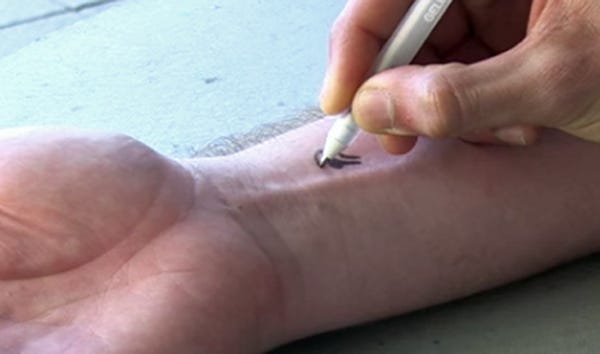A Surprisingly Simple Solution for Glucose Monitoring
March 11, 2015
Nanoengineers at the University of California, San Diego think diabetics might be able to draw the sensors on their skin using special high-tech bio-inks.
Chris Newmarker
|
UC San Diego researchers have demonstrated that they can draw sensors directly on the skin. (Photo courtesy of UC San Diego) |
Will diabetics someday need to watch old Bob Ross clips so that they can draw their own glucose sensors?
The notion sounds pretty silly, but it might not be as far-fetched as it seems, if research out of the University of California, San Diego is any indication.
The UC San Diego researchers developed high-tech bio-inks that react with several chemicals, including glucose. They then filled off-the-shelf ballpoint pens with the inks and drew reusable glucose-measuring sensors on a pattern printed on a transparent, flexible material that included an electrode. They demonstrated that they could take glucose measurements off blood dropped on the material, wipe the pattern clean, draw a new pattern, and take a measurement again.
One pen has enough ink to draw 500 high-fidelity glucose sensor strips, according to the UC San Diego nanoengineers, who published their findings in the February 26 issue of Advanced Healthcare Materials. Better yet, they've demonstrated that they can draw sensors directly on the skin. The sensors are able to communicate with a potentiostat --a Bluetooth-enabled electronic device that controls electrodes--to gather data.
The team--led by Joseph Wang, chairman of the Department of NanoEngineering and director of the Center for Wearable Sensors at UC San Diego--has had a focus on finding alternatives to standard needle-based glucose monitoring. Late last year, they announced a temporary tattoo that could monitor glucose.
The new ink technology could have uses that go well beyond glucose monitoring, though. Wang and his colleagues envision sensors drawn on leaves and building walls for pollution monitoring, and on smartphones for personalized and inexpensive health monitoring.
Our new biocatalytic pen technology, based on novel enzymatic inks, holds considerable promise for a broad range of applications on site and in the field," Wang said in a news release.
A major challenge behind the technology involving creating inks safe for humans and plants that are also able to function as electrodes and retain properties over long periods of time in storage or other conditions. Researchers eventually hit on using biocompatible polyethylene glycol, used in several drug delivery applications, as a binder. Graphite powder could be used to make the inks conductive. And chitosan, an antibacterial agent used in bandages to reduce bleeding, enables the ink to adhere to surfaces. The ink also includes xylitol, a sugar substitute, which helps stabilize enzymes that react with several chemicals the sensors are designed to monitor.
Refresh your medical device industry knowledge at BIOMEDevice Boston, May 6-7, 2015. |
Chris Newmarker is senior editor of Qmed and MPMN. Follow him on Twitter at @newmarker.
Like what you're reading? Subscribe to our daily e-newsletter.
About the Author(s)
You May Also Like


